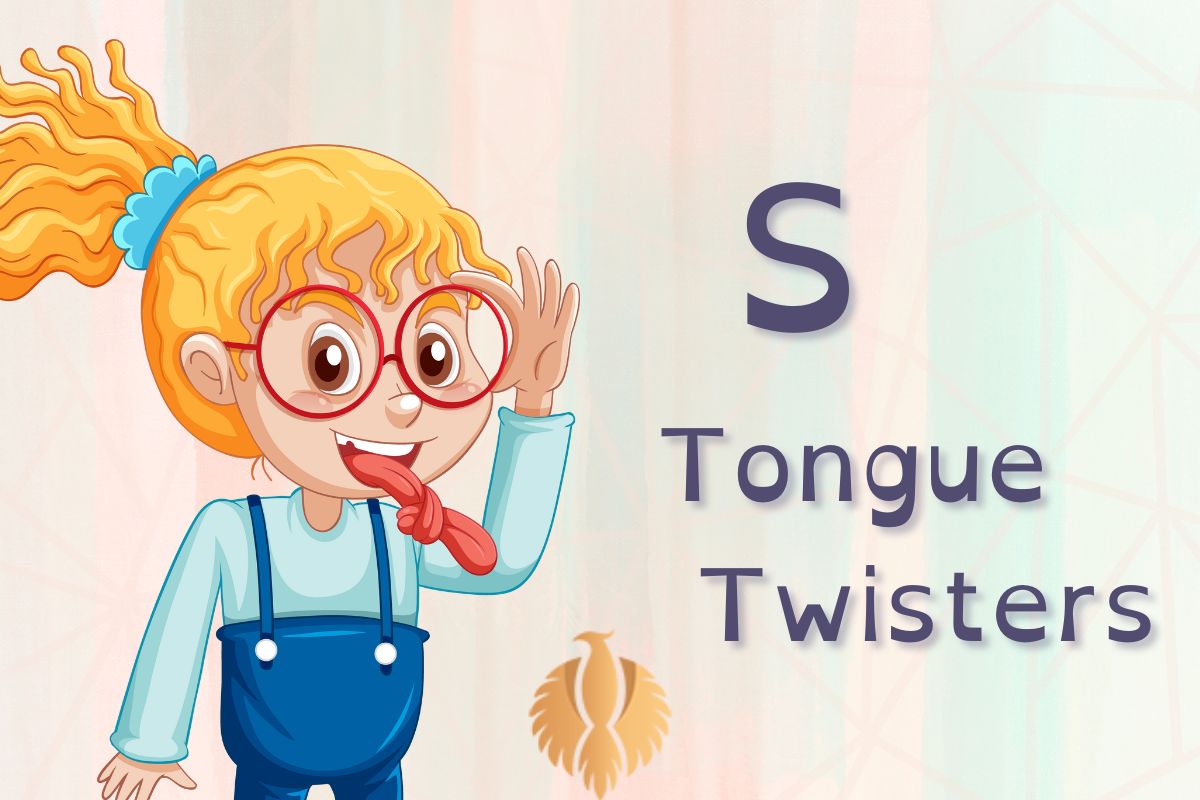Tongue twisters are playful linguistic exercises designed to challenge one’s pronunciation skills by featuring sequences of similar or closely related sounds. For example, the classic tongue twister “She sells seashells by the seashore” contains a repetitive sequence of ‘S’ sounds, creating a delightful linguistic obstacle. Engaging with such tongue twisters encourages individuals to refine their articulation and enunciation skills.
Among the many categories of tongue twisters, those revolving around the letter ‘S’ are particularly intriguing. These tongue twisters not only entertain but also serve as valuable tools for improving diction, clarity, and overall verbal agility. If you’re interested in learning more about tongue twisters, keep on reading this article!
You might also enjoy:Which of the Following: Definition + Complete Usage + Grammar

The rhythmic repetition of ‘S’ sounds challenges the speaker to navigate through the sequence swiftly and accurately, promoting linguistic precision. Furthermore, ‘S’ tongue twisters contribute significantly to language learning and speech therapy. They offer an enjoyable way to enhance phonetic awareness, emphasizing the importance of distinct sounds in effective communication.
As individuals practice these tongue twisters, they sharpen their ability to differentiate between similar sounds, fostering linguistic dexterity.
The playful nature of ‘S’ tongue twisters also makes them a popular choice for linguistic games and activities. Whether used in classrooms or social settings, these tongue twisters bring laughter and camaraderie as individuals attempt to master the intricate sequences.
The shared experience of grappling with the challenge creates a sense of camaraderie and fosters a positive attitude toward language learning. Beyond their educational and entertainment value, ‘S’ tongue twisters hold cultural significance.
They are often embedded in folklore and passed down through generations, becoming a delightful part of oral traditions. As linguistic artifacts, these tongue twisters connect individuals across time, reflecting the timeless appeal of language play.
‘S’ tongue twisters are more than linguistic puzzles; they are versatile tools that entertain, educate, and connect. By weaving a tapestry of challenging sounds, these tongue twisters invite individuals to explore the nuances of pronunciation and embrace the joy of mastering language.
Whether used for educational purposes, speech therapy, or simply for amusement, ‘S’ tongue twisters add a touch of linguistic flair to the rich tapestry of human communication.
Here are some popular tongue twisters involving the letter “S”
- Silly Sammy swiftly shooed seven silly sheep.
- Six slippery snails slid slowly seaward.
- Susie works in a shoeshine shop. Where she shines, she sits, and where she sits, she shines.
- Swan swam over the sea, Swim, swan, swim! Swan swam back again, Well swum, swan!
These tongue twisters are known for their repetition of the “S” sound, which makes them challenging to say quickly and accurately. They are a fun way to test your pronunciation skills and have some lighthearted fun with friends and family.
You Might Also Enjoy:Reinforce Vs Reenforce: 10 Differences + Examples [2025]
Here are a few tongue twisters focused on the letter ‘S’:

| 1. She sells seashells by the seashore, |
| The shells she sells are surely seashells. |
| So if she sells shells on the seashore, |
| I’m sure she sells seashore shells. |
| 2. Sally sold sea shells by the sea shore. |
| But if Sally sells sea shells by the sea shore, |
| Then where are the sea shells Sally sells? |
| 3. Six slippery snails, slid silently seaward. |
| 4. Silly Sam silently sipped a sudsy soda. |
| 5. Susan shines shoes and socks; |
| socks and shoes shines Susan. |
A famous tongue twister with a lot of ‘S’ sounds is:
“She sells seashells by the seashore,
The shells she sells are surely seashells.
So if she sells shells on the seashore,
I’m sure she sells seashore shells.”
This tongue twister is known for its repetition of ‘S’ sounds, making it challenging and fun to say quickly.
You might also enjoy:Where Does “How is your Day Going?” Originate From?
Here are some popular tongue twisters involving the letter “S”
- She sells seashells by the seashore.
- Sally sells seashells by the seashore.
- Silly Sammy swiftly shooed seven silly sheep.
- Six slippery snails slid slowly seaward.
- Susie works in a shoeshine shop. Where she shines, she sits, and where she sits, she shines.
- Swan swam over the sea, Swim, swan, swim! Swan swam back again, Well swum, swan!
These tongue twisters are known for their repetition of the “S” sound, which makes them challenging to say quickly and accurately.
They are a fun way to test your pronunciation skills and have some lighthearted fun with friends and family.
What is the tongue twister with a lot of S?

A famous tongue twister with a lot of ‘S’ sounds is:
“She sells seashells by the seashore,
The shells she sells are surely seashells.
So if she sells shells on the seashore,
I’m sure she sells seashore shells.”
This tongue twister is known for its repetition of ‘S’ sounds, making it challenging and fun to say quickly.
What tongue twisters make you say the S word?
It seems there might be a misunderstanding. Tongue twisters are word combinations that are challenging to pronounce rapidly and accurately due to their repetitive or difficult sounds.
They are designed to be playful exercises for improving articulation and pronunciation, not to make you say a specific word.
If you have a specific word or theme in mind, I can try to help you come up with a tongue twister or provide information related to that topic. Let me know how I can assist you!
What is the hardest tongue twister?
Determining the absolute “hardest” tongue twister is subjective, as it can vary from person to person based on their native language, accent, and personal challenges with certain sounds. However, one often mentioned as challenging is:
“The sixth sick sheik’s sixth sheep’s sick.”
This tongue twister involves repeating the “s” and “sh” sounds, making it difficult for many to say rapidly without stumbling. Remember, the difficulty can vary, so feel free to try it and see how well you navigate the challenge!
What are tongue twisters with Z and S?

Here are some tongue twisters that involve both ‘Z’ and ‘S’ sounds:
| 1. Zebras zig and zebras zag, zealously seeking zigzags. |
| 2. Sally swiftly shooed seven silly sheep. |
| 3. Zara’s zesty zinnias zestfully swayed in the breeze. |
| 4. Six slippery snakes silently slithered sideways. |
| 5. Zeke’s zeppelin soared swiftly over zigzagging streams. |
Give these a try to challenge your pronunciation skills with both ‘Z’ and ‘S’ sounds!
Here are some ‘S’ tongue twisters that can be beneficial for speech therapy, specifically targeting the ‘S’ sound:
- Sammy swiftly sweeps spilled sugar.
- Sally’s sunny, yellow sandals silently squeak.
- Six slippery snails slid slowly southward.
- Susie sells seashells by the serene seashore.
- Sally’s sister Sarah is sewing stylish scarves.
These tongue twisters focus on repetitive ‘S’ sounds and can be useful for individuals working on improving their clarity and articulation of the ‘S’ sound in speech therapy.
You might also enjoy:Interested In or On: The Differences + Examples [2025]
What are 10 tongue twisters?
Here are ten tongue twisters for you:
- She sells seashells by the seashore,
The shells she sells are surely seashells.
So if she sells shells on the seashore,
I’m sure she sells seashore shells.
- Peter Piper picked a peck of pickled peppers.
How many pickled peppers did Peter Piper pick?
- Unique New York, you need New York.
You know you need unique New York.
- How can a clam cram in a clean cream can?
- Fred fed Ted bread and Ted fed Fred bread.
- A black bug bleeds black blood, and a blue bug bleeds blue blood.
- Six slippery snails, slid silently seaward.
- I saw Susie sitting in a shoeshine shop.
Where she sits, she shines, and where she shines, she sits.
- Swan swam over the sea.
Swim, swan, swim!
Swan swam back again.
Well swum, swan!
- How can you noiselessly nose-nudge a noisy, napping narwhal?
Enjoy these tongue twisters, and have fun mastering the art of pronunciation!
S tongue twisters speech therapy
Here are some ‘S’ tongue twisters that can be beneficial for speech therapy, specifically targeting the ‘S’ sound:
- Sammy swiftly sweeps spilled sugar.
- Sally’s sunny, yellow sandals silently squeak.
- Six slippery snails slid slowly southward.
- Susie sells seashells by the serene seashore.
- Sally’s sister Sarah is sewing stylish scarves.
These tongue twisters focus on repetitive ‘S’ sounds and can be useful for individuals working on improving their clarity and articulation of the ‘S’ sound in speech therapy
What are some popular tongue twisters involving the letter “S”?
Here are some popular tongue twisters involving the letter “S”:
- She sells seashells by the seashore.
- Susie works in a shoeshine shop. Where she shines, she sits, and where she sits, she shines.
- Silly Sammy swiftly shooed seven silly sheep.
- Six slippery snails slid slowly seaward.
- Swan swam over the sea, Swim, swan, swim! Swan swam back again, Well swum, swan!
These tongue twisters are known for their repetition of the “S” sound, which makes them challenging to say quickly and accurately.
They are a fun way to test your pronunciation skills and have some lighthearted fun with friends and family.
How do tongue twisters challenge pronunciation skills?
Tongue twisters challenge pronunciation skills because they often contain a sequence of similar or repetitive sounds, syllables, or words.
This repetition makes it difficult for the speaker to enunciate the words clearly and quickly.
The challenge comes from the need to articulate each sound precisely and rapidly, which can be a test of one’s ability to control the movement of the tongue, lips, and vocal cords.
Additionally, tongue twisters often involve sounds that are known to be challenging for many individuals to pronounce accurately, such as sibilant sounds (like “s” and “sh”) or consonant clusters (like “sw” or “sl”).
By requiring the speaker to repeatedly articulate these difficult sounds in quick succession, tongue twisters help to improve overall diction, enunciation, and speech clarity.
Furthermore, the rapid and repetitive nature of tongue twisters can also help to improve coordination between the brain and the muscles involved in speech production.
.
This can be especially beneficial for individuals who are working to overcome speech impediments or language barriers, as it helps to train the muscles involved in speech production and improve overall communication skills.
Tongue twisters challenge pronunciation skills by requiring the speaker to accurately and quickly articulate a sequence of sounds, syllables, or words that are often difficult to pronounce.
This can help improve diction, enunciation, and overall speech clarity, making tongue twisters a fun and beneficial tool for language practice and speech improvement.
You might also enjoy:What Kind of Vs What Kinds of – Differences + Examples [2025]
How can tongue twisters benefit individuals with speech impediments?

Tongue twisters can benefit individuals with speech impediments in several ways:
1.Articulation and Pronunciation: Tongue twisters require precise articulation and pronunciation of specific sounds and syllables. Practicing tongue twisters can help individuals with speech impediments to improve their ability to produce these sounds accurately, which is a key aspect of speech therapy.
2.Coordination and Muscle Control: Tongue twisters can help improve the coordination and control of the muscles involved in speech production. For individuals with speech impediments, such as stuttering or lisping, practicing tongue twisters can help train the tongue, lips, and vocal cords to work together more effectively, leading to clearer and more fluent speech.
3.Confidence Building: Mastering difficult tongue twisters can boost confidence in speaking abilities. For individuals with speech impediments, achieving success in pronouncing challenging tongue twisters can be a source of encouragement and motivation, helping to build confidence in their speech and communication skills.
4.Speech Therapy Tool: Speech therapists often use tongue twisters as a fun and engaging tool in therapy sessions. The repetitive nature of tongue twisters can be used to target specific speech difficulties and provide a structured way to practice and improve speech patterns.
5.Fun and Engaging Practice: Tongue twisters offer a playful and enjoyable way to practice speech exercises. For individuals with speech impediments, using tongue twisters as part of their practice routine can make speech therapy more enjoyable and less daunting.
Tongue twisters can benefit individuals with speech impediments by improving articulation, building muscle coordination, boosting confidence, providing a structured speech therapy tool, and offering a fun and engaging way to practice speech exercises.
What are some examples of tongue twisters that can be helpful for individuals with speech impairments?
For individuals with speech impairments, it’s important to choose tongue twisters that specifically target the sounds or speech patterns they are working on. Here are some examples that cover a range of sounds:
1.Walter walked with Wendy, wondering why Wally was whistling.
(Targets ‘W’ sounds)
2.Fuzzy Wuzzy was a bear. Fuzzy Wuzzy had no hair. Fuzzy Wuzzy wasn’t very fuzzy, was he?
(Targets ‘F’ sounds)
3.Charlie chose cheesy chili for lunch.
(Targets ‘CH’ sound)
4.Larry’s lazy lizard lounged lazily in the sunny sand.
(Targets ‘L’ sounds)
5.Tommy takes ten tiny turtles to the terrific town.
(Targets ‘T’ sounds)
Tailor the tongue twisters to focus on the specific sounds that need improvement. Consistent practice can be beneficial in speech therapy.
You might also enjoy:Too Cute Meaning Vs To Cute (To Vs Too) + Examples
How often should individuals with speech impediments practice tongue twisters to see impairment?

The frequency of practicing tongue twisters for individuals with speech impediments can vary based on the severity of the impairment, individual progress, and the guidance of a speech therapist. Generally, regular and consistent practice is key. Here are some considerations:
1.Daily Practice: Ideally, incorporating tongue twisters into daily practice routines can be beneficial. Short sessions, multiple times a day, might be more effective than longer, infrequent sessions.
2.Guidance from a Speech Therapist: A speech therapist can provide personalized recommendations on the frequency and types of exercises based on the specific speech impediment and individual progress.
3.Gradual Progression: Start with simpler tongue twisters and gradually increase complexity as speech improves. This helps build confidence and avoids frustration.
4.Incorporate into Daily Conversations: Encourage the use of targeted sounds during regular conversations. This practical application reinforces the learned speech patterns.
5.Consistency is Key: Consistency is more important than intensity. Regular, sustained practice over time is likely to yield better results than sporadic, intense practice.
Remember, it’s essential for individuals with speech impediments to work closely with a speech therapist who can assess their specific needs and provide tailored guidance. They can monitor progress and adjust the practice routine accordingly.
Are there any potential drawbacks limitations to using tongue twisters as a speech therapy tool ?
While tongue twisters can be a valuable tool in speech therapy, there are some potential drawbacks and limitations to consider:
1.Isolation of Sounds: Tongue twisters often isolate specific sounds or patterns, and while this can be helpful for targeted practice, it may not fully address the complexities of natural speech.
2.Generalization to Real Communication: The challenge with tongue twisters is ensuring that the improved pronunciation and articulation generalize to everyday communication. It’s essential to bridge the gap between isolated exercises and real-world speech.
3.Frustration: Tongue twisters can be frustrating, especially for individuals with severe speech impediments. Too much frustration might hinder motivation and progress.
4.Lack of Personalization: Not all tongue twisters address the unique needs of an individual’s speech impediment. A tailored approach, designed by a speech therapist, might be more effective.
5.Overemphasis on Speed: Some tongue twisters prioritize speed, which may lead to sacrificing clarity. For individuals with speech impediments, focusing on accuracy is often more important than speed.
6.Not a One-Size-Fits-All Solution: Speech impediments vary widely, and what works well for one individual may not be as effective for another. A personalized approach to speech therapy is crucial.
7.Potential for Mispronunciation: If practiced without guidance, there is a risk of reinforcing incorrect pronunciation. Regular feedback from a speech therapist is essential.
Can tongue twisters help improve communication skills in multiple languages?

Yes, tongue twisters can be beneficial for improving communication skills in multiple languages. Here’s how:
1.Articulation and Pronunciation: Tongue twisters are designed to challenge pronunciation and articulation. Practicing them in different languages can enhance clarity and accuracy in producing specific sounds unique to each language.
2.Phonetic Awareness: Tongue twisters help develop phonetic awareness, making it easier to distinguish and produce different sounds in various languages. This is particularly useful for languages with distinct phonetic characteristics.
3.Language-Specific Challenges: Each language has its own set of sounds and phonetic challenges. Tongue twisters tailored to a specific language can address these challenges and improve overall oral proficiency.
4.Speech Rhythm and Fluency: Tongue twisters often involve rapid repetition of sounds, contributing to improved speech rhythm and fluency. This can be valuable for individuals communicating in multiple languages.

5.Confidence Building: Successfully mastering tongue twisters in different languages can boost confidence in speaking those languages. This confidence translates into more effective communication.
6.Cultural and Linguistic Context: Some tongue twisters are deeply rooted in the cultural and linguistic context of a language. Practicing these can enhance one’s understanding of the language and its nuances.
However, it’s important to note that while tongue twisters can be a useful supplementary tool, they should be part of a broader language-learning strategy.
Regular practice, exposure to native speakers, and immersion in the language are also crucial components of effective language acquisition and communication skills in multiple languages
You might also enjoy:How Are You Fairing or Faring? Differences + Examples
Conclusion
In conclusion, mastering tongue twisters that focus on the “r” sound can be both rewarding and enjoyable for anyone seeking to improve their English pronunciation. The distinct pronunciation of the “r” sound varies across languages and dialects, making it notoriously challenging.
Classic examples like “Round the rugged rocks the ragged rascal ran” and “Rory’s roaring, raucous, and rowdy rabbits” require precise articulation and coordination, serving as excellent exercises for improving diction and enunciation.
Regular practice with these tongue twisters enhances speech control and pronunciation accuracy, benefiting language learners, actors, public speakers, and voice artists alike. Moreover, they contribute to broader language skills by enhancing phonemic awareness and overall speech patterns.
The playful nature and inherent challenges of “r” tongue twisters foster cognitive development and add a competitive element, making them a favorite pastime in various settings.
By embracing the linguistic adventure of “r” tongue twisters, individuals can navigate the intricate landscape of pronunciation with finesse, transforming language practice into a delightful journey of mastering phonetics.

Hi, welcome to my blog! My name is Omid and I am thrilled to have you here! I am an English language teacher with 12 years of experience and hold multiple international certifications (TESOL, IELTS, TOEFL, PTE, CELTA). Additionally, I hold a PhD in Applied Linguistics with a specialization in Teaching English as a Second Language (TESL), which fuels my passion for teaching English and assisting others in mastering the language. To me, nothing is more rewarding than helping individuals enhance their English language abilities through various methods. So, let’s embark on this journey of learning English together.




